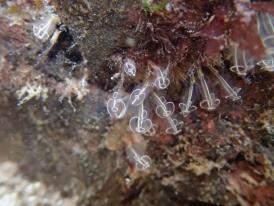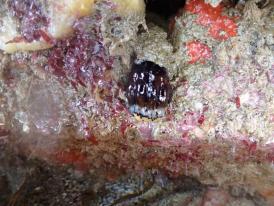Sea Squirts on the Lizard.....
The Lizard peninsula was the objective for the annual Coastwise excursion, christened "Sea Squirts", organised brilliantly by Mavis Symons.
Members formed a little village of up to four campervans and a tent at the local campsite, and others used a variety of B&Bs, hotels and the Youth Hostel.
The Saturday venue was Kennack sands, with its extensive rock pools and overhung gullies providing a sheltered environment with very different fauna than North Devon.
The Lizard peninsula has unusual geology, with, as part of the Devonian mountain-building era (Variscan Orogeny), a subduction by which very deep rock from the junction of the Earth's core and the mantle came to the surface under conditions of extreme heat and pressure. This has resulted in the attractive Serpentine, and basalt and peridotite rock that form the backdrop to Kennack. Other signs of this activity are visible at Lizard and Mullion Island, where pillow lava, or lava extruded underwater resulting in bulbous shapes, are visible.
It's difficult to pick out highlights, but members and our expert guides, Trudy and Jason found and identified sea slugs, unusual sponges, lightbulb sea squirts, lovely ascidians, and a St Pirrans crab. Members also saw the mating process of ragworms, with their legs modified from digging legs to swimming legs. Females first deposited large volumes of eggs, then as the tide rose a few minutes later, males deposited sperm which mixed with the eggs - lucky timing for Coastwise.
The plan for Sunday was to change venue to Polpeor at Lizard Point, but with the shift in wind direction from SE to due W it was decided to stay with Kennack, but move over the the E end of the rocks. This was less weedy and produced a different range of animals with many more of the usual suspects lurking under stones.
A selection of the finds is shown R. From top, Janolus cristatus sea slug, female Ragworm depositing eggs, Fascelina auriculata sea slug, Bugola bryozoan possibly, Botryllus schlosseri ascidian, unidentified fish eggs at an advanced stage of development, Amphiura chiajei brittle star, Ophiothrix fragilis brittle star possibly (both the latter under the same rock), intrusion of red serpentine into peridotite and basalt, light bulb sea squirt and a sea cucumber (Pawonia saxicola) [latter two courtesy of Paula Ferris].
Copyright Coastwise



